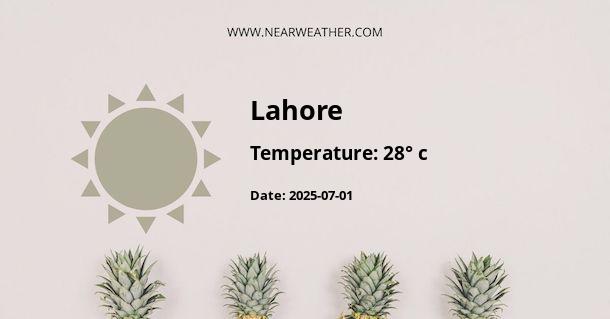Lahore, Pakistan: Climate and Weather Year-Round
Lahore, the capital city of the Punjab province in Pakistan, experiences a subtropical continental climate. The city is known for its hot summers, mild winters, and a significant variation in temperatures throughout the year. Understanding the climate and weather patterns of Lahore is essential for residents and travelers to plan their activities and make appropriate preparations. Let's take a closer look at the climate and weather conditions in Lahore throughout the year.
Temperature
Lahore experiences four distinct seasons, each characterized by different temperature ranges. The city's location in the eastern part of Pakistan contributes to its unique climate. Here is a breakdown of the average temperatures in Lahore:
| Season | Average Temperature (°C) |
|---|---|
| Spring (March to May) | 20°C to 30°C |
| Summer (June to August) | 30°C to 40°C |
| Autumn (September to November) | 20°C to 30°C |
| Winter (December to February) | 5°C to 15°C |
The summer season in Lahore is particularly hot and dry, with temperatures often exceeding 40°C. It's essential to stay hydrated and protect yourself from the sun when visiting during this time. Winters, on the other hand, are relatively mild and pleasant, with temperatures rarely dropping below 5°C.
Rainfall
Lahore experiences a distinct wet and dry season pattern when it comes to rainfall. The monsoon season brings the majority of the city's annual precipitation. Here is an overview of the average monthly rainfall in Lahore:
| Month | Average Rainfall (mm) |
|---|---|
| January | 18 mm |
| February | 20 mm |
| March | 25 mm |
| April | 13 mm |
| May | 18 mm |
| June | 54 mm |
| July | 130 mm |
| August | 112 mm |
| September | 50 mm |
| October | 9 mm |
| November | 4 mm |
| December | 12 mm |
As seen from the table, the monsoon season starts in June and continues until September, with July and August receiving the highest amount of rainfall. It is important to note that heavy rainfall during the monsoon season can lead to occasional flooding and disruption in the city. It is advisable to stay updated with weather forecasts and take necessary precautions during this time.
Humidity
Lahore experiences relatively high humidity levels throughout the year, particularly during the summer season. The humidity can often reach above 70%, making the hot weather feel even more uncomfortable. However, during the winter season, the humidity levels tend to be lower, making the cooler temperatures more pleasant.
Fog
During the winter months, Lahore is prone to dense fog, which can significantly reduce visibility and cause travel disruptions. The fog usually occurs in the early morning and late evening hours, so it is advisable to plan outdoor activities accordingly and take necessary precautions while driving.
Extreme Weather Events
While Lahore generally experiences stable weather conditions, it is important to be prepared for occasional extreme weather events. Thunderstorms, heavy rains, and heatwaves can occur, especially during the summer months. It is advisable to stay informed about weather forecasts and follow any instructions or warnings issued by local authorities.
Conclusion
Lahore's climate and weather patterns offer a mix of hot summers, mild winters, and a distinct wet and dry season. Understanding the temperature ranges, rainfall patterns, and other weather factors can help residents and visitors make informed decisions about their daily activities and be prepared for any extreme weather events. Stay updated with weather forecasts and take necessary precautions to ensure a comfortable and safe experience in Lahore.
A - Lahore's Latitude is 31.549721 & Longitude is 74.343613.
A - Weather in Lahore is 30° today.
A - Climate Conditions in Lahore shows haze today.
A - Humidity in Lahore is 42% today.
A - Wind speed in Lahore is 11.12 km/h, flowing at 310° wind direction. today.
